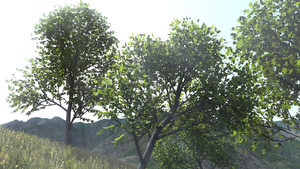Information
- Publication Type: Miscellaneous Publication
- Workgroup(s)/Project(s):
- Date: 2009
- Keywords: Real-Time Rendering, Trees, Animation
Abstract
This demonstration combines novel methods for physically accurate yet efficient rendering and animation of trees under dynamic lighting conditions. A new leaf shading method is used that models the high-frequency structures such as veins and bulges to reproduce all important lighting attributes on a physical basis. Those structures are also used to calculate the translucency of leaves, which is modeled with physically based subsurface scattering, incorporating self-shadowing, thickness variations and varying albedo. This allows consistent reflective and translucent shading without constraining lighting or animation for close-up views. The individual deformation and animation of leaves and branches is defined by their physical properties such as shape and elasticity. A structural mechanics model is solved and combined with a length correction to achieve a physically plausible bending. To model the tree-wind interaction, a spectral approach is applied that allows for a physically guided animation as well as a high level of control. The applied methods have been published in "Physically Based Real-time Translucency for Leaves (EGSR 2007)" and "Physically Guided Animation of Trees (Eurographics 2009)".Additional Files and Images
Additional images and videos
 low res video:
Animation in SD (XVID.360p30)
low res video:
Animation in SD (XVID.360p30)
 Screenshot:
Screenshot
Screenshot:
Screenshot
 video:
Animation in HD (H.264.720p30)
video:
Animation in HD (H.264.720p30)
Additional files
Weblinks
No further information available.BibTeX
@misc{Habel-09-RAT,
title = "Real-Time Rendering and Animation of Trees",
author = "Ralf Habel and Alexander Kusternig",
year = "2009",
abstract = "This demonstration combines novel methods for physically
accurate yet efficient rendering and animation of trees
under dynamic lighting conditions. A new leaf shading method
is used that models the high-frequency structures such as
veins and bulges to reproduce all important lighting
attributes on a physical basis. Those structures are also
used to calculate the translucency of leaves, which is
modeled with physically based subsurface scattering,
incorporating self-shadowing, thickness variations and
varying albedo. This allows consistent reflective and
translucent shading without constraining lighting or
animation for close-up views. The individual deformation and
animation of leaves and branches is defined by their
physical properties such as shape and elasticity. A
structural mechanics model is solved and combined with a
length correction to achieve a physically plausible bending.
To model the tree-wind interaction, a spectral approach is
applied that allows for a physically guided animation as
well as a high level of control. The applied methods have
been published in "Physically Based Real-time Translucency
for Leaves (EGSR 2007)" and "Physically Guided Animation of
Trees (Eurographics 2009)". ",
month = aug,
keywords = "Real-Time Rendering, Trees, Animation",
URL = "https://www.cg.tuwien.ac.at/research/publications/2009/Habel-09-RAT/",
}
